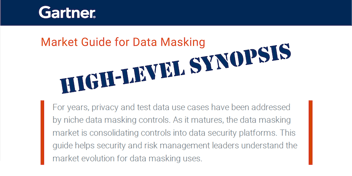Different use cases call for different data masking methods. Learn about some of the most important data masking methods, as well as when to use each.
Diverse Data Masking Methods Give Enterprises an Advantage
Data masking protects sensitive data by obscuring or replacing real PII (Personally Identifiable Information) with scrambled, yet statistically equivalent, data. Having the ability to deploy a variety of data masking methods enables enterprises to enforce a high data security and compliance standard across all production, analytical, and business use cases.
Indeed, masking data is one of the most secure ways to anonymize data because the original data cannot be identified, or reverse engineered. It’s commonly used to de-identify sensitive data to comply with consumer privacy regulations, financial information, PHI (Protected Health Information), and intellectual property.
Production and analytics teams alike favor data masking tools, because masked data remains functional for use cases such as customer 360, test data management, data migration, and legacy application modernization.
In this article, we’ll cover the most common data masking methods, how they relate to different use cases, and the pros and cons of each.
Top Data Masking Methods
-
Data Anonymization
Data anonymization is a data masking method that involves removing or obscuring PII from a dataset in a way that makes it impossible to identify the individual or entity it corresponds to. It’s usually used to remove or obscure information such as contact and payment information, IP addresses, or device IDs.
Common data anonymization use cases include:
– Data analytics
Companies that collect data from customers need to anonymize it before using it for analytics and research purposes. Otherwise, they risk privacy compliance violations of regulations like GDPR, CCPA, HIPAA, SOX, APPI, DCIA, PDP, and more, depending on geographic jurisdictions and relevant industries.– Digital advertising
Marketing teams can anonymize users’ personal information related to their online behavior before utilizing it for ad targeting.– Public datasets
Government agencies may collect data and release it to the public in an anonymized format to protect citizens' privacy.– Medical research
Medical data often contains sensitive information about patients (PHI) that needs to be anonymized before it can be shared with other researchers or made accessible to the public.Here are the main pros and cons of data anonymization:
Pros
Cons
Considered to be one of the most effective data masking techniques for protecting individuals’ privacy
Requires expertise in data privacy management, as well as in local and international regulations
Enables data sharing with stakeholders that would not otherwise have access to certain datasets, such as researchers, analysts, or the general public
If not executed properly, datasets may still contain information that could be used to re-identify an individual, even though direct identifiers (name, address) have been removed or obscured
Anonymized data remains functional, so it can be operationalized for testing, research, analytics, customer support, and more
May not be suitable for real-time workloads because the anonymization process can add latency to the data pipeline
-
Data Pseudonymization
Data pseudonymization is a data masking method in which sensitive information, such as a name or driver's license number, is swapped with a fictional alias or random figures. Although the data is de-identified, it can be re-identified if necessary. Data pseudonymization can be applied to both structured and unstructured data, like a photocopy of a passport.
Common data pseudonymization use cases include:
– Fraud detection
Financial services firms can use data pseudonymization to detect and prevent fraud while maintaining customer privacy. For example, a customer's account number and social security number could be replaced with a unique identifier, such as a code number, which can then be used to analyze customer transactions and look for patterns that could indicate fraud.– Customer analytics
Data pseudonymization can be used to analyze customer behavioral data, for marketing and customer experience purposes, without exposing identifying information and risking non-compliance.Here are the main pros and cons of data pseudonymization:
Pros
Cons
Can partially mask personal identifiers, such as replacing only a last name instead of a full name
Can expose sensitive information if the mapping algorithm, that links the real identity to the pseudonym, is decoded and accessed
Supports compliance with data privacy regulations that require organizations to protect personal information while maintaining data utility
Can be complex to implement and manage, particularly when there are massive amounts of personal identifiers or pseudonyms to deal with
-
Encrypted Lookup Substitution
Encrypted lookup substitution is a data masking method in which sensitive data is replaced with non-sensitive data using encryption and a lookup table, where the sensitive data is encrypted and stored in the table with a corresponding non-sensitive value.
Common encrypted lookup substitution use cases include:
– Retail and eCommerce
Encrypted lookup substitution can be used to protect sensitive customer information, while enabling retail and eCommerce companies to analyze customer behavior and preferences for marketing and retargeting purposes.– Sharing data with third parties
Organizations can allow their third parties to access datasets without fear of a security breach or noncompliance, ensuring sensitive information remains concealed.– Automation
Encrypted lookup substitution allows companies to de-identify sensitive information used in automated systems without exposing it to risk, such as when checking an individual’s credit score to approve a loan.Here are the main pros and cons of encrypted lookup substitution:
Pros
Cons
Provides an additional layer of security by encrypting sensitive data, and making it more difficult for unauthorized people to access or misuse it
Increases the complexity, and the corresponding amount of computing resources, needed for data processing
The encrypted lookup table can be stored separately from the data it corresponds to, so hackers are less likely to gain access to the original data
Secure key management, standard in such solutions, might require additional resources and expertise
-
Redaction
Redaction is a data masking method that involves obscuring, removing, or replacing sensitive data with generic values – in databases, or development and testing environments. Redaction makes sensitive information unreadable or inaccessible, while still allowing the rest of a document, dataset, or database to be used. It’s useful when the sensitive data itself isn’t necessary for QA or development, and when test data can differ from the original datasets.
Common redaction use cases include:
– Code and configuration files
Sensitive information such as credentials or private keys could be included in the code or configuration files in a development or testing environment. You can redact this information before sharing the code/files with others, or committing them to a version control system.– Test data management
Test data may contain customer PII that must be redacted to prevent a data breach or noncompliance with customer privacy regulations.– Log files
Log files generated in development, or by test data management tools, may contain sensitive information that should be redacted before non-authorized users can access them.Here are the main pros and cons of data redaction:
Pros
Cons
Enforces compliance with data privacy regulations
May increase the cost and complexity of automated or manual redaction processes
Maintains the confidentiality and privacy of individuals, as well as organizations
Reduces data utility for analysis or decision-making
Secures sensitive data against unauthorized access
Unable to redact all instances of personal data, leading to potential breaches
-
Shuffling
Shuffling is a data masking method in which the order of elements in a dataset (such as rows or columns) is rearranged in a random manner to obscure the association between sensitive information and the individuals or entities to whom it pertains.
Common data shuffling use cases include:
– Customer data in a CRM
Shuffling allows marketers or salespeople to conceal the association between PII and customer/prospect identities within the Customer Relationship Management (CRM) system to protect customer privacy and comply with regulations.– Data Warehouse or Data Lake
Shuffling can be used in data warehouses, or data lakes, to protect sensitive information that pertains to customers or employees.Here are the main pros and cons of data shuffling:
Pros
Cons
Ensures datasets remain whole, realistic, and functional – without removing any data – by obscuring the association between the sensitive information and the person to whom it pertains
Difficulty verifying that all instances of sensitive data have been properly shuffled – especially in large volumes – while maintaining relational integrity
Provides a simple method for anonymizing research data, or masking financial data
May result in data that doesn’t follow the same distribution style as the original data, which can affect data analytics or ML models
Get the Most out of Every Data Masking Method with Business Entities
The entity-based data masking technology provides a comprehensive solution for protecting sensitive information by enabling data masking best practices, and more. It allows authorized users to access all of the data related to a specific business entity, such as customers, payments, orders, and devices, while keeping the data secure.
Instead of centralizing sensitive information, like other data protection solutions, it utilizes Micro-Databases™ that are individually encrypted to manage and persist each instance of a business entity.
A business entity solution protects sensitive data, whether it's at rest, in use, and in transit – or in various environments such as production, testing, and analytics. It offers dynamic and static masking options, for both structured and unstructured data, while maintaining relational integrity.
Unlike many other data anonymization tools, it allows you to automatically implement a variety of data masking methods to unstructured data fields, such as images, PDFs, and text files that may contain sensitive information. By ensuring all instances of sensitive data are protected in compliance with data privacy regulations, you can sustain analytical and operational workloads without interruption.
For organizations seeking a variety of data masking methods, and looking to avoid vulnerabilities associated with traditional solutions, taking a business entity approach is the ideal choice.













